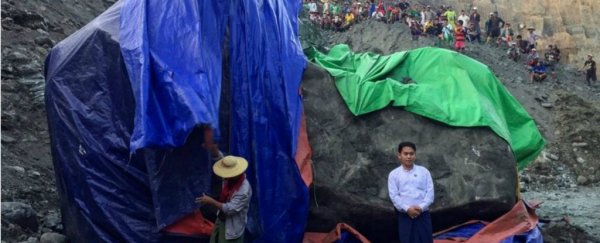Miners in Myanmar have unearthed a huge jade stone weighing 175 tonnes, and worth an estimated US$170 million.
According to the BBC, the near-translucent green stone measures 4.3 metres (14 feet) high, and 5.8 metres (19 feet) long, and was discovered in a mine in the state of Kachin, in the north of the country.
It's estimated that around 70 percent of the world's finest jade comes from Myanmar (formerly known as Burma), with the industry making up around half of the country's gross domestic product.
It's unclear whether a single stone of this size has been found before, but it's in the same league as other geological wonders, such as the world's second largest diamond, which was found last year, and this rare violet diamond, which miners recently unearthed in Australia.
Although most of us just think of jade as one type of green gem stone, it actually refers to two similar, but structurally different, types of metamorphic rock: jadeite and nephrite.
Jadeite is more common in Myanmar, and is what this stone is likely made of, although that won't be definite until its chemical composition is analysed further. Both types of stone can be classified as the gem stone jade.
In its uncut, and untreated form, like it is in the image above, the vibrant green of the stone is hard to see, and it ends up looking like a pretty ordinary, dull rock, with a slightly dark green tinge.
But after it's been chiselled and polished, it ends up looking glassy and green, like in the statue from the Huntington Museum of Art in the US, below:
As with most of the jade discovered in the country, the stone will probably be sent across the border to China to be carved into jewellery and sculptures.
Local politician U Soe Tint told The Independent that the piece of jade was as big as two small houses: "I assume that it is a present for the fate for our citizens, the government and our party as it was discovered in the time of our government. It's a very good sign for us."
Unfortunately, Myanmar's jade industry has been mired in controversy and complaints of environmental negligence.
A study released back in 2015 by Global Witness also revealed that the US$31 billion jade industry was being used as a "slush fund" by military elites and drug lords in the country - who were likely selling the gem stone for profits that the rest of the country wouldn't see.
"Myanmar's jade industry may well be the biggest natural resource heist in modern history. The sums of money involved are almost incomprehensibly high and the level of accountability is at rock bottom," the report stated.
In response to the report, the recently elected government - the first civilian government the country has had since 1962 - announced ground-breaking reforms back in August to put a stop to corruption, abuse, and environmental wrongdoing in the jade industry.
And in response to a series of deadly landslides, the government has already suspended operations at more than 2,000 jade mines in Kachin state until environmental impact studies could be completed
Let's hope that with renewed interest in regulating the industry, and the publicity surrounding this latest discovery, the profits end up where they deserve - with the people of the country

